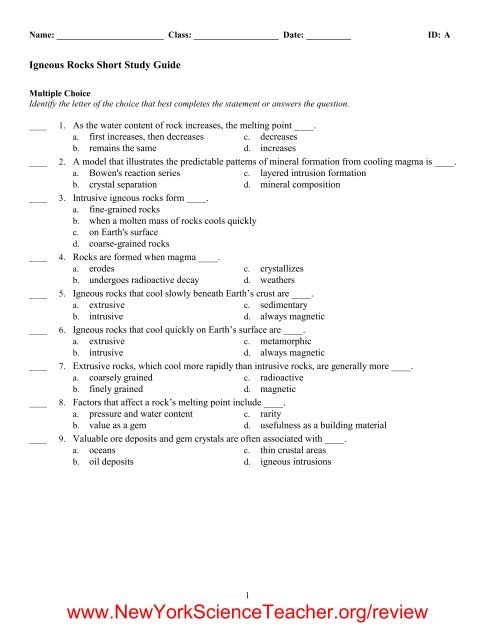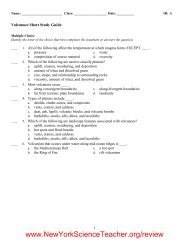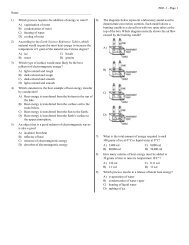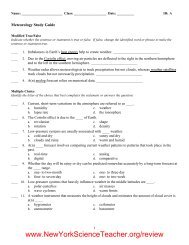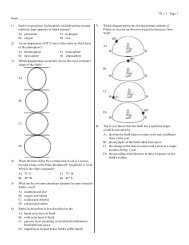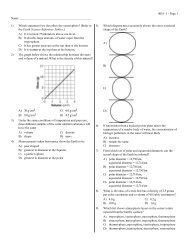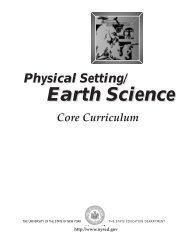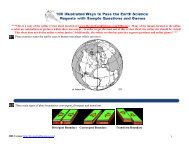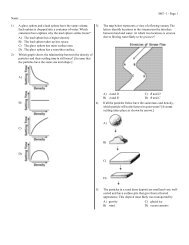Igneous Rocks Short Study Guide - Earth Science Regents Prep ...
Igneous Rocks Short Study Guide - Earth Science Regents Prep ...
Igneous Rocks Short Study Guide - Earth Science Regents Prep ...
You also want an ePaper? Increase the reach of your titles
YUMPU automatically turns print PDFs into web optimized ePapers that Google loves.
Name: ________________________ Class: ___________________ Date: __________ ID: A<br />
<strong>Igneous</strong> <strong>Rocks</strong> <strong>Short</strong> <strong>Study</strong> <strong>Guide</strong><br />
Multiple Choice<br />
Identify the letter of the choice that best completes the statement or answers the question.<br />
____ 1. As the water content of rock increases, the melting point ____.<br />
a. first increases, then decreases c. decreases<br />
b. remains the same d. increases<br />
____ 2. A model that illustrates the predictable patterns of mineral formation from cooling magma is ____.<br />
a. Bowen's reaction series c. layered intrusion formation<br />
b. crystal separation d. mineral composition<br />
____ 3. Intrusive igneous rocks form ____.<br />
a. fine-grained rocks<br />
b. when a molten mass of rocks cools quickly<br />
c. on <strong>Earth</strong>'s surface<br />
d. coarse-grained rocks<br />
____ 4. <strong>Rocks</strong> are formed when magma ____.<br />
a. erodes c. crystallizes<br />
b. undergoes radioactive decay d. weathers<br />
____ 5. <strong>Igneous</strong> rocks that cool slowly beneath <strong>Earth</strong>’s crust are ____.<br />
a. extrusive c. sedimentary<br />
b. intrusive d. always magnetic<br />
____ 6. <strong>Igneous</strong> rocks that cool quickly on <strong>Earth</strong>’s surface are ____.<br />
a. extrusive c. metamorphic<br />
b. intrusive d. always magnetic<br />
____ 7. Extrusive rocks, which cool more rapidly than intrusive rocks, are generally more ____.<br />
a. coarsely grained c. radioactive<br />
b. finely grained d. magnetic<br />
____ 8. Factors that affect a rock’s melting point include ____.<br />
a. pressure and water content c. rarity<br />
b. value as a gem d. usefulness as a building material<br />
____ 9. Valuable ore deposits and gem crystals are often associated with ____.<br />
a. oceans c. thin crustal areas<br />
b. oil deposits d. igneous intrusions<br />
1<br />
www.NewYork<strong>Science</strong>Teacher.org/review
Name: ________________________ ID: A<br />
Matching<br />
Match each item with the correct statement below.<br />
a. felsic e. pegmatite<br />
b. kimberlite f. porphyritic<br />
c. lava g. ultramafic<br />
d. mafic<br />
____ 10. Magma that flows out onto <strong>Earth</strong>'s surface<br />
____ 11. Dark-colored rock such as gabbro that is rich in iron and magnesium<br />
____ 12. Rock that is very high in iron and magnesium<br />
____ 13. Vein of extremely large-grained minerals<br />
____ 14. Ultramafic rock that can contains diamonds<br />
<strong>Short</strong> Answer<br />
15. A group of igneous rocks are found. The rocks all have very low silica contents. Based on this<br />
characteristic alone, to what group of igneous rocks do these rocks likely belong?<br />
Compare and contrast each pair of related terms or phrases.<br />
16. intrusive igneous rock, extrusive igneous rock<br />
17. magma, lava<br />
18. Which rock type or feature forms when rapid cooling of magma does not allow its calcium-rich core<br />
to react completely with the magma?<br />
19. What is partial melting? Explain how partial melting affects igneous rock formation.<br />
20. What is fractional crystallization? Does it add or remove elements from magma? Explain your<br />
answer.<br />
21. Why would crystals formed early in magma crystallization have larger, better-shaped crystals than<br />
those that formed later?<br />
2<br />
www.NewYork<strong>Science</strong>Teacher.org/review
Name: ________________________ ID: A<br />
The diagram shows the proportions of minerals in common igneous rocks. Use the diagram to<br />
answer the following questions.<br />
22. What four groups of igneous rocks are shown in the diagram?<br />
23. What categories of rock grain are shown on the diagram?<br />
24. Rock Sample A is coarse-grained, 90 percent olivine, and 10 percent pyroxene. What is the name of<br />
the rock? What group is it in?<br />
3<br />
www.NewYork<strong>Science</strong>Teacher.org/review
Name: ________________________ ID: A<br />
Problem<br />
25. According to the diagram below, what elements are removed from this particular magma during<br />
fractional crystallization? What effect does this have on the overall proportions of the remaining<br />
elements—Al, Ca, Si, O, Na, and K—in the magma?<br />
4<br />
www.NewYork<strong>Science</strong>Teacher.org/review
MULTIPLE CHOICE<br />
1. C<br />
2. A<br />
3. D<br />
4. C<br />
5. B<br />
6. A<br />
7. B<br />
8. A<br />
9. D<br />
MATCHING<br />
10. C<br />
11. D<br />
12. G<br />
13. E<br />
14. B<br />
SHORT ANSWER<br />
<strong>Igneous</strong> <strong>Rocks</strong> <strong>Short</strong> <strong>Study</strong> <strong>Guide</strong><br />
Answer Section<br />
1<br />
ID: A<br />
15. The rocks are either mafic or ultramafic igneous rocks, depending on how high the levels of iron and<br />
magnesium are.<br />
16. Both describe the formation of igneous rock. Fine-grained rocks that cool quickly on <strong>Earth</strong>’s surface<br />
are extrusive igneous rocks. Coarse-grained igneous rocks that cool slowly beneath <strong>Earth</strong>’s surface<br />
are intrusive igneous rocks.<br />
17. Both are molten rock. Magma is molten rock below <strong>Earth</strong>’s surface, while lava is magma that flows<br />
out onto <strong>Earth</strong>’s surface.<br />
18. a zoned crystal<br />
19. Partial melting describes how different minerals melt at different temperatures. The resulting magma<br />
and the rocks that form when the magma cools have a different chemical composition than that of the<br />
original rock.<br />
20. Fractional crystallization describes how different minerals form at different temperatures. It removes<br />
elements because as the minerals crystallize, they are no longer part of the magma.<br />
21. Early-forming, slower-cooling minerals may have time to form larger, well-shaped crystals because<br />
crystallization occurs in an unconfined space, while later-forming, quick-cooling crystals have<br />
irregular shapes because they form in a confined space and lack time to form.<br />
22. felsic, intermediate, mafic, ultramafic<br />
23. coarse-grained, fine-grained, and very coarse-grained<br />
www.NewYork<strong>Science</strong>Teacher.org/review
PROBLEM<br />
24. It is peridotite. It is categorized as ultramafic.<br />
2<br />
ID: A<br />
25. Mg and Fe are removed and crystallized. This increases the overall proportion of all other elements<br />
in the magma.<br />
www.NewYork<strong>Science</strong>Teacher.org/review


